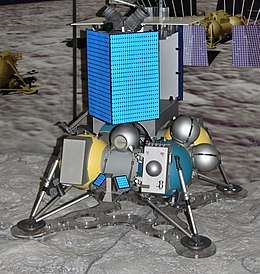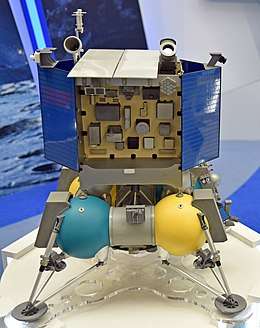Luna-Glob
Luna-Glob (Russian: Луна-Глоб, meaning Lunar sphere) is a Moon exploration programme by Roscosmos meant to progress toward the creation of a fully robotic lunar base. When completed, the programme will continue with crewed lunar missions, starting with a crewed orbiter spacecraft called Orel.[1]
The programme is based on plans dating back to 1997. Due to the 1998 Russian financial crisis however, the programme's first mission, the Luna 25 lander, was put on hold, only to be revived a few years later. Initially scheduled for launch in 2012[2] by a Soyuz-2 rocket,[3] the first mission has been delayed many times, first to 2014, then to 2015[4][5] and 2016[6][7] and 2018[8] and 2019.[9] Russia's Roscosmos approved a model of the Luna 25 lander in 2017.[10][11]
As of September 2019, Luna 25 is planned to be launched in 2021, Luna 26 in 2024, Luna 27 in 2025, Luna 28 in 2025–2027, Luna 29 in 2028, and Luna 30 and 31 by 2030 (see List of missions).
History
The Luna-Glob programme is a continuation of the Soviet Union Luna programme that sent at least 24 orbiters and landers between 1959 and 1976 to the Moon, of which fifteen were successful. The last mission was Luna 24, launched on 9 August 1976.
Initially, the first Luna-Glob mission was planned as orbiter with ground penetrating sensors.[12] Four Japanese-built penetrators inherited from the Lunar-A were to be used, each 45 kg (100 lb), including 14 kg (31 lb) for the penetrator proper. Furthermore, seismic experiments were planned, including the use of four penetrators, which will slam into the lunar surface equipped to detect seismic signals. These experiments are expected to help clarify the origin of the Moon. Two of the penetrators are planned to land near the Apollo 11 and Apollo 12 landing sites, taking advantage of seismic data gathered there from 1969 to 1974. The payload of the orbiter will total 120 kg (260 lb) and include astrophysics experiments, dust monitors, plasma sensors, including the LORD astronomy payload, designed to study ultra-high-energy cosmic rays.[13]
Luna-Resurs (Luna 27) was initially planned as a joint orbiter-rover mission (the orbiter was to be the Indian Chandrayaan-2) that would have featured a 58 kg Russian rover and lander, as part of the cancelled International Lunar Network.[14] This joint mission would have landed in the Moon's south pole, examine a crater and operate for up to one year.[14] Because the loss of the Fobos-Grunt in 2011 which was planned as a test for the landing system, Russia cited its inability to provide the lander and rover within the proposed time. India then decided to develop the lunar mission independently.[15]
List of missions
Unlike their predecessors, the new Luna missions are targeted at the lunar poles.[16] As of 2019, the next missions have been announced:[17][18][19]
| Spacecraft | Proposed launch | Notes | Launch vehicle |
|---|---|---|---|
| Luna 25 (Luna-Glob Lander) | October 2021[20] | South pole lander | Soyuz 2.1b |
| Luna 26 (Luna-Resurs Orbiter) | 2024[21][22] | Lunar orbiter | Soyuz 2.1b |
| Luna 27 (Luna Resurs Lander) | August 2025[23] | South pole lander[24][25] | Soyuz 2.1b |
| Luna 28 (Luna Grunt) | 2027[26][27] | South pole lander and sample-return | Soyuz 2.1b |
| Luna 29 (Luna-Resurs-PS) | 2028[28] | South pole rover,[29][30] and sample-return[31] | Angara A5/KVTK[32] |
| Luna 30 (Luna-Orbita-1) | ~2030[28] | ||
| Luna 31 (Luna-Orbita-2) | ~2030[28] |
Gallery
 Luna 25
Luna 25 Luna 26
Luna 26 Luna 27
Luna 27
Future lunar base
It was planned in 2008 that Luna-Glob, a "robotic proving ground", would be followed by a robotic base, known in Russian as Lunny Poligon - or Lunar Range,[33] and this base would progress with the construction of a habitable lunar base that would have several components: solar power station, telecommunication station, technological station, scientific station, long-range research rover, landing and launch area, and a telecom orbiting satellite.[34][35][36]
When the robotic phase is completed, the programme will continue with crewed lunar missions in the 2030s, starting with a crewed orbiter mission on a spacecraft called Orel.[1][37] As of 2017, Russia is planning to begin building the lunar base in the 2030s.[1]
References
- The vision of the Russian Space Agency on the robotic settlements in the Moon. Maxim Litvak, IKI/Roscosmos. 2016.
- "Fundamental Space Studies". Russian Federal Space Agency. Archived from the original on 7 April 2008. Retrieved 27 June 2008.
- "Lavochkin begins phase B work for Luna-Glob 1 orbiter". www.flightglobal.com. Retrieved 16 October 2008.
- Российский зонд Луна-Глоб отправится исследовать Луну в 2015 году
- "First Russian moon mission delayed". Space Exp. Retrieved 17 October 2013.
- Roscosmos: Fundamental space researches
- "Future planetary missions". Space Exp. Retrieved 17 October 2013.
- Russia will launch Luna spacecraft in 2018
- "Russian Moon missions face three-year delay". Retrieved 7 August 2015.
- "Russia presenting model of Luna-25 Moon exploration spacecraft at Le Bourget Air Show 2015". TASS (in Russian). Retrieved 21 November 2017.
- "Roscosmos Approves Luna-25 Space Station Model in Moon Exploration Project". Retrieved 18 August 2017.
- "Russia Plans Ambitious Robotic Lunar Mission". Aviation Week. Retrieved 27 June 2008.
- Luna-Glob at Skyrocket
- Luna-Resurs at RussianSpaceweb
- "Chandrayaan-2: India to go it alone". The Hindu. 22 January 2013. Retrieved 22 January 2013.
- Russian Moon exploration programme. Russian Research Institute (IKI). 2017.
- Russian Moon missions face three-year delay
- The vision of the Russian Space Agency on the robotic settlements in the Moon. (PDF). Maxim Litva. ROSCOSMOS. 2016.
- "Luna-Glob (Luna 25)". space.skyrocket.de. Retrieved 14 February 2019.
- "Россия запустит космический аппарат на Луну 1 октября 2021 года" [Russia will launch a spacecraft to the moon on October 1, 2021]. RIA Novosti (in Russian). 17 March 2020. Retrieved 14 April 2020.
- "Рогозин сообщил о переносе запусков станций "Луна-26" и "Луна-27"" [Rogozin announces the postponement of launches of the Luna-26 and Luna-27 stations]. RIA Novosti (in Russian). 11 April 2019. Retrieved 17 September 2019.
- "Запуск двух российских аппаратов к Луне отложили на год". РИА Новости (in Russian). 10 January 2019.
- "Интервью Владимира Колмыкова" [Interview with Vladimir Kolmykov]. Roscosmos (in Russian). 14 April 2020. Retrieved 14 April 2020.
- Space Operations: Contributions from the Global Community. Craig Cruzen, Michael Schmidhuber, Young H. Lee, Bangyeop Kim. Springer, Mar 30, 2017 - Technology & Engineering - 718 pages.
- Stella Tkatchova (2017). Emerging Space Markets. Springer Berlin Heidelberg. p. 56. ISBN 978-3-662-55669-6.
- Российский космос: история будущего. 26 January 2019 – via YouTube.
- "Россия планирует доставить образцы лунного грунта на Землю в 2027 году" [Russia plans to deliver lunar soil samples to Earth in 2027]. RIA Novosti (in Russian). 29 January 2019. Retrieved 17 September 2019.
- "Luna-29 mission may be led by robot". Hitecher. 14 May 2019. Retrieved 17 September 2019.
- Robotic Missions of Russian Lunar Program. (PDF). Alexander Zakharov & Ilia Kuznetsov.
- Destination Moon: Russia to Launch New Wave of Lunar Robots. Leonard David, Space. April 1, 2013.
- Russian Aerospace Firm to Cooperate With China on Moon Exploration Missions. Sputnik News. 8 June 2017.
- Pietrobon, Steven (11 August 2018). "Russian Launch Manifest". Retrieved 11 August 2018.
- Luna Grunt. Anatoly Zak, Russian Space Web. Accessed 19 June 2018.
- "Russian project Luna-Glob: goals and status" (PDF). Retrieved 21 October 2008.
- "RETURN TO THE MOON: NEXT STEPS" (PDF). Retrieved 21 October 2008.
- "Russia To Build Lunar Base By 2037", Xinhua, 26 January 2011.
- Return Vehicle for PTK Federatsiya transport spacecraft. Anatoly Zak, Russian Space Web. September 6, 2018.

